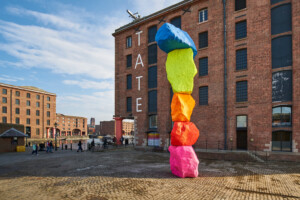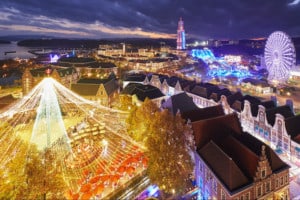The exquisitely restored neo-Classical exterior of 300 Stewart Street in Las Vegas both belies and embodies its storied past. The iconic building played a key role in local and U.S. history, as well as in popular culture. It now houses remnants of some of the nation’s most violent crimes and most notorious criminals.
Related: The World's Most Spectacular Museum? Cairo's Grand Egyptian Museum Project/ The Museum of the City of New York: Phase II
By Tricia M. McC unney, Hill International
unney, Hill International
For just over a year now, 300 Stewart Street has been home to the National Museum of Organized Crime and Law Enforcement, or the “Mob Museum” to us regular folks. The 41, 000-square-foot museum uses interactive exhibits and chilling artifacts splattered over three floors to explore the tumultuous history of both organized crime and law enforcement. The divergent yet interconnected stories of crime versus law and order, good versus evil, shadow versus light are present throughout the instantly popular museum.
Those contrasting themes also pepper both the building’s history and the road to its restoration over the past decade.
The building at 300 Stewart Street was built in 1933 to serve as a federal courthouse and city post office. According to local historians, the classically striking structure was built to be a shining beacon and gentrifying force among a street chock full of brothels and other places that catered to society’s “dark side.” Within a decade of its construction, the building had helped to change the face of Stewart Street and became the centerpiece of a growing downtown Las Vegas.
For years, 300 Stewart Street stood stalwart as Las Vegas grew and prospered; a place where both historic legal precedent and humble postage stamps were dispensed daily. Then, in November 1950, the courthouse shot to prominence, serving as one of 14 courthouses across the nation for the Kefauver hearings on organized crime. The hearings were initiated by Tennessee Senator Estes Kefauver to investigate and expose to a largely naïve nation the growing presence of organized crime and its threat to interstate commerce.
While the hearings did little to stem organized crime, they did illuminate both the problem and the players. The hearings also fanned interest in the city itself, as both an up-and-coming tourist destination and a permanent home for those who saw promise and opportunity there. One such transplant was Oscar B. Goodman, who came to Las Vegas in 1964 as a young defense attorney, and who went on to defend some of organized crime’s most notable, or notorious, figures over his career.
A Philadelphia native and Ivy League graduate, Goodman loved Las Vegas. After a long career in law, he spring-boarded into a career in politics. In 1999, Goodman became mayor of Las Vegas, vowing to restore its beleaguered historic district to its former opulence.
Not long after, the federal government reportedly sold 300 Stewart Street to the city for $1, with the stipulation that it be restored and used for cultural purposes. Then in 2002, little more than 50 years after the Kefauver hearings, Goodman announced his controversial plan to restore 300 Stewart Street for a “mob” museum, a museum dedicated to the interplay between crime and law enforcement, good and evil, and the light and shadow that are at the heart of both the building and the city itself. Notably, Goodman was joined in the fig ht to get the project completed by former FBI Special Agent in Charge, Ellen Knowlton, a 24-year Bureau veteran who headed its Las Vegas Division.
ht to get the project completed by former FBI Special Agent in Charge, Ellen Knowlton, a 24-year Bureau veteran who headed its Las Vegas Division.
A decade later, the National Museum of Organized Crime and Law Enforcement opened on February 14, 2012. The decision to open on a day remembered for both enduring love and excruciating violence was absolutely premeditated, museum officials acknowledged at the time. The infamous Valentine’s Day Massacre, involving the murder of seven organized crime figures by rival Capone gangmen on Chicago’s South Side, had made international headlines 83 years earlier. (The wall where seven men were lined up and gunned down is one of the most chilling of the Mob Museum’s large-scale artifacts.)
Brian Benson, senior project manager and general superintendent at APCO Construction, the general contractor on the Mob Museum project, said the work there walked a similar tightrope. Work had to proceed quickly, but with much care, he said. Each portion of the 48, 000 square-foot, 70-year-old building had to be updated to meet 21st-century building codes, while its historic aspects were repaired and preserved. “The basement and other levels needed seismic updates to bring the building up to code for earthquakes. At the same time, we had to go in and update the mechanical, electrical, and fire response systems while still meeting the design intent for the museum, ” he explained.
Before any work could begin, however, historic furniture and fixtures – doors, windows, light fixtures, judges’ benches and other precious pieces – had to be carefully removed for restoration or placed into safe, climate-controlled storage. Walls, floors and other historic elements left in place had to be protected during demolition and construction. Work on any part of the building had to be planned and pre-approved, and done with extreme care and concentration – all of which took considerable time.
The building’s age meant that parts of its structure didn’t meet modern building and safety codes, and had to be upgraded – all without affecting its historic aspects. Because of the building’s dimensions and its historic significance, getting materials into the building wasn’t easy, and required much pre-planning. In addition, the project had to meet stringent LEED standards for environmental responsibility and sustainability. “Even on a new building, obtaining LEED Silver certification presents challenges. On an historic project, those challenges increase exponentially, ” Benson said.
Historic restoration isn’t easy in a town like Las Vegas, where the culture supports knocking things down and starting new. Contractors and subcontractors that specialize in historic projects are scarce there, and workers aren’t experienced in the delicate balance between productivity and preservation. That didn’t stop the project team, however, from forging ahead, ensuring that skilled workers were hired, or those already hired learned the skills they needed.
Also challenging were several layers of oversight, from the architect and other members of the project team, to various city and state agencies, to the federal government. Because the U.S. government contributed to the restoration of the building, the project was carefully watched by the Department of the Interior.
.jpg)
To help maintain the aggressive yet fluid project schedule, APCO retained international construction consultant Hill International to augment its staff. Hill International provided scheduling and delay analysis services that helped APCO and its subcontractors navigate the myriad RFIs, design changes, unforeseen conditions and other pitfalls common to historic projects, if not all complex construction projects.
“Planning and scheduling were crucial, ” said Raquel Speers Shohet, a Hill International vice president and project manager on the Mob Museum project. “The project required an incredible amount of coordination. Every single day, we had a coordination meeting to make sure that we had things planned out as far ahead as we could to keep everyone on task and to moving forward as efficiently as possible.”
Shohet and her staff were retained to scrutinize the smallest details, but not lose sight of the overall goals of the project and the roles that every team member played in its successful completion. “The Mob Museum was the brainchild of our mayor, and very dear to his heart. It was his intention that the building would be a legacy after he retired. Because of that, the project was under a lot of scrutiny, and it was critical that we meet our schedule milestones.”
As the project neared its end, work had to progress while the Valentine’s Day Massacre wall and other priceless museum pieces were being delivered and installed. Benson said his proudest day was the day that the museum exhibits started arriving. “You really feel as if you’re part of history, ” he said.
The museum was designed by Dennis and Kathy Barrie, who also designed the Rock and Roll Hall of Fame and Museum in Cleveland, Ohio, and the International Spy Museum in Washington, D.C. Robert J. Chattal of Chattal Architecture, Planning & Preservation, provided vital architectural preservation consulting. The exhibits were planned and executed by Gallagher & Associates of Washington, D.C., responsible for exhibits at the Jamestown Settlement in Virginia and the Normandy American Cemetery Visitor Center in France. “It took a lot of planning and hard work by many people to get the building restored and the museum open, ” Benson said.
Benson and Shohet hope that the success of the Mob Museum project will spur interest in restoring more of the city’s early twentieth-century properties. Like their predecessors in the 1930s, both think that 300 Stewart Street will be a shining beacon that gently gentrifies a neighborhood that could use a little polish – again.











